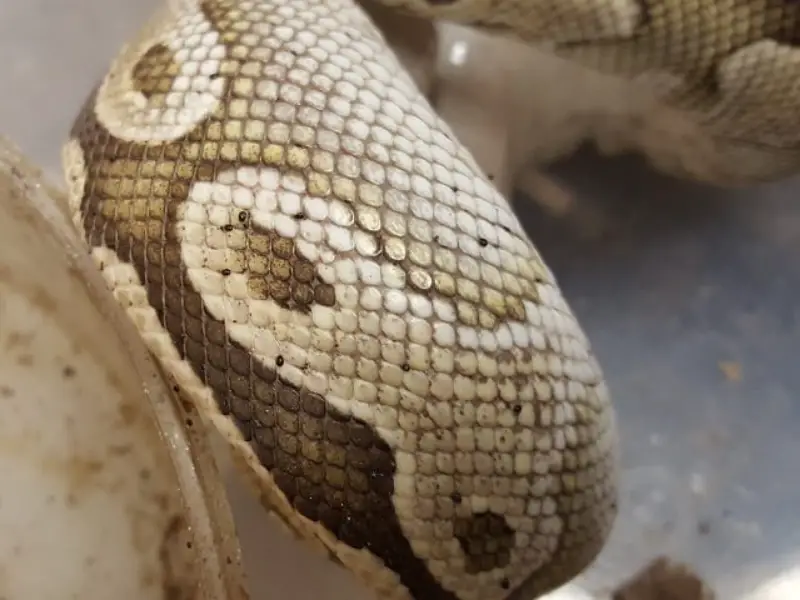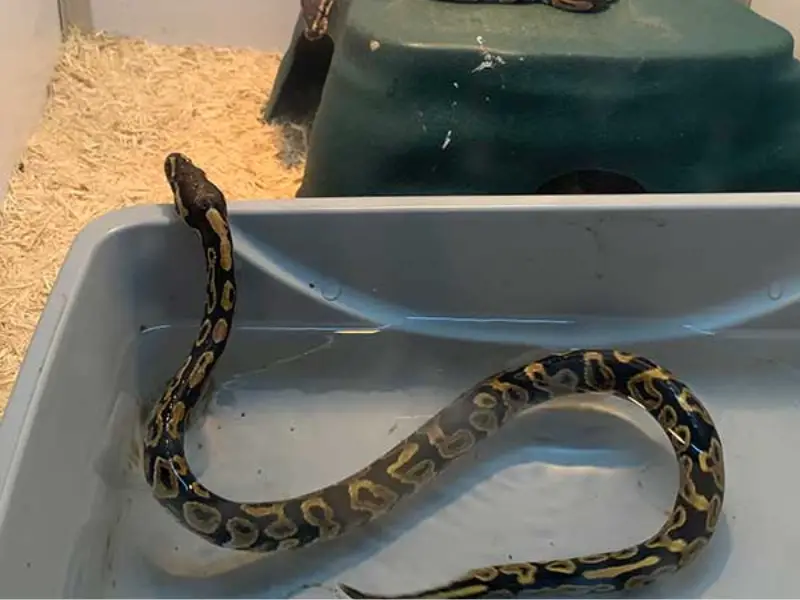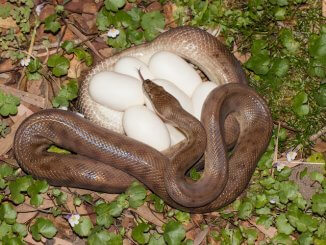
Whether you are a snake-owning newbie or a veteran, chances are you’ve heard about mites on snakes. Mites are a common problem that most snake owners will face at one point or another.
But because they are common doesn’t mean that you shouldn’t take them seriously. While one mite doesn’t pose a problem, most mite infestations end up with thousands of mites.
An infestation can lead to significant health complications for your snake, including anemia, septicemia, and even death.
That’s why we’ve put together a comprehensive guide covering everything you need to know about treating and preventing a snake mite infestation.
What Are Snake Mites?

Snake mites are parasites that feed on your snake’s blood. A single female mite generally lays thousands of eggs during her lifetime.
Mites can cause severe health problems for your snake. Many mites sucking your snake’s blood can easily lead to anemia (low levels of healthy red blood cells) and the open wounds could allow for infection or lead to septicemia (blood poisoning).
While snake mites exist in the wild, they are less likely to establish a full-fledged infestation. Since wild snakes are always on the move, they inadvertently remove mites from their skin.
Female mites don’t lay their eggs on snakes. When the female mite goes to lay eggs, the wild snake that had the mite will likely be somewhere else by the time the eggs hatch. Despite this, mite infestations in the wild do occur.
Unfortunately, infestations are much more likely to occur in captive snakes. The female mite will lay eggs in the enclosure and soon the snake will be infested with thousands of mites.
Mites on snakes are an even bigger problem if you have an extensive collection of snakes or reptiles. It is easy for snake mites to spread from one enclosure to another.
Snake mites only affect reptiles and cannot cause harm to humans. So you don’t need to worry about the safety of yourself or your family when dealing with a snake mite infestation.
Types Of Snake Mites
There are over 200 different kinds of parasitic snake mites that could attack your snake. However, three major types of mites are most likely to be found on your snake and in its enclosure.
The most common is the Ophionyssus natricis, primarily found on snakes but can also be present on other captive reptiles.
These snake mites look like tiny reddish-black specks. They are visible to the human eye but can still be hard to spot.
The two other kinds of mites you are likely to find on your snake are Ophionyssus acertinus, which are more orange-red, and red Trombiculidae mites, also called chiggers or berry bugs.
The treatment and preventative measures are the same regardless of what type of mite you are dealing with.
How To Identify If Your Snake Has Mites
There are both behavioral and physical signs of snake mites. Let’s have a look at the main things to keep an eye out for when looking for snake mites.
Behavioral Signs Of Mites On Snakes
The first step in working out if your snake has mites is seeing if it behaves strangely. You must be familiar with your snake’s normal behavior, temperament, and activity levels. The better you know your snake, the better you can look after it.
When it comes to abnormal behavior, there are two possible things you could observe. The first is irritability and restlessness. If your snake is moving around more than usual or seems unable to get comfortable, it may have mites.
This movement comes with lots of head twitching or weaving side to side. Your snake is doing this because of the irritation caused by the mites.
The second behavioral abnormality is lethargy. If your snake stops being as active as before, this is a cause for concern. Inactivity could result from mites draining blood. A lack of blood causes anemia and low energy levels.
Whether or not you suspect mites, lethargy in snakes is always a cause for concern and merits a visit to the vet.
Another thing to constantly monitor is your snake’s appetite. You should always look into the cause of sudden drops in appetite that aren’t related to shedding or preparing to brumate.
One other unusual behavior you might notice if your snake has mites is excessive soaking.
If your snake suddenly starts spending far more time soaking in its water bowl, this could be a sign that it is trying to soothe the irritation from the mites.
Physical Signs Of Mites On Snakes
When it comes to physical signs to look out for, check for swollen eyes or raised scales. Mites gather around a snake’s eyes, causing them to swell up.
The next step is to look for raised scales. When checking for scale abnormalities, it is a good idea to rub against the grain of the scales to catch them more easily.
You should also keep an eye out for dysecdysis (abnormal shedding). If your snake is not shedding or only sheds in patches, there is almost certainly something wrong.
It might not always be mites though. For instance, abnormal shedding could be due to too little humidity, dehydration, or something worse.
If your snake has mites, it’s relatively easy to spot them. You might notice small black or red dots in your snake’s water bowl.
It is also possible to see these dots and spots on your hands after handling your snake. You may even see the spots around the enclosure.
You can see the mites moving around on your snake in extremely severe cases. It will present as small black-red dots moving around the snake’s eyes, mouth, chin, and nose.
Because there are so many different types of mites, you also need to be on the lookout for gray or orange dots. When snake mites defecate, they leave behind small white, visible spots.
The bottom line is that you should always pay close attention to your snake’s behavior and appearance.
This rule is valid when it comes to catching mites and a whole host of other health conditions.
How To Get Rid Of Snake Mites In 3 Steps

Let’s go over what to do if you discover that you do have a snake mite infestation. The first step is always the same: take your snake to the vet. Getting proper medical treatment is imperative.
There are three primary steps to eliminating snake mites: treating your snake, treating its enclosure, and doing another checkup.
Doing one without the other will result in the infestation returning.
Step 1: Take Your Snake To The Vet
When you suspect a snake mite infestation, the first step is to take them to a specialized vet that caters to snakes. Snakes are unique and interesting animals and require specific veterinary care.
Snake mite infestations can cause other complications such as anemia, a compromised immune system, and behavioral changes.
Taking your pet to the vet means that it will get the care that it needs.
When taking the snake to the vet, it is best to transport it in a glass container so that the vet can inspect the snake before handling it.
Once they have completed their inspection, there are a few treatment options that the vet can do.
Treating Snake Mites With Insecticides
The most effective treatment against snake mites is insecticides. Still, because of how toxic these treatments can be, only a vet should administer them.
The most common insecticides used are Ivermectin and different types of pyrethroid.
Some common forms of pyrethroid include permethrin, metofluthrin, and tetramethrin. Your vet will likely spray your snake down with one of these insecticides.
While these insecticides can be toxic, they can also be beneficial when cleaning your snake’s cage to eliminate mites.
Spraying the cage with one of these insecticides and then leaving it empty for 48 hours can help immensely.
We’ll look at all the steps you can do to clean the enclosure once we’ve covered the best things to do for your snake.
There are some options that are less toxic than the higher-strength insecticides only a vet can administer.
You could also ask your vet for a diluted Ivermectin or pyrethroid spray to use at home. Refrain from mixing these sprays yourself, as mistakes can be deadly to your snake.
Treating Snake Mites With Carbaryl Powder
Another solution for treating the mites on your snake is carbaryl powder. This powder is very effective and is not harmful if breathed in by your snake in small amounts. However, it can still pose health risks to your snake if you mishandle it.
Because of the potential risk, it’s best to let a registered vet complete this process. The vet will place your snake in a ventilated container with a thin layer of carbaryl powder.
The snake will then be left in the powder for several hours before being removed and rinsed with an insecticide like Ivermectin.
Treating Snake Mites With A Betadine Bath
At home, in conjunction with treatments from the vet, you can give your snake a Betadine bath. Take Betadine, which is a povidone-iodine solution, and create a bath for your snake.
Aim for a dilution of 1 part Betadine to 10 parts water. The water should end up a light brown color.
The bath can be a large container with a lid. The water should be between 75 – 85 °F and should not be deep enough for your snake to drown in.
Ensure there are proper ventilation holes in the top.
Place your snake in the Betadine-water solution and leave it to soak in the solution for 30 minutes to an hour.
When you take the snake out, rinse it thoroughly with clean water and dry it off. You can repeat this bath every few days until you are sure there are no mites on your snake.
After the Betadine bath, you will likely see many small black-red spots floating in the water. This is a good sign because it means the mites are dying and no longer on the snake.
If you own multiple snakes, an excellent preventative measure is to give the rest of your snakes a Betadine bath if you find out that one of your snakes has mites.
Snake mites spread quickly between animals, and you should monitor your snakes and other reptiles closely.
Step 2: Deep Cleaning The Enclosure
Removing the mites on your snake is only helpful if you also ensure that its environment is free of mites and eggs.
If you reintroduce the snake to an environment with even one mite present, you will not solve the mite problem.
To clean the enclosure, wash it several times with hot, soapy water. The mites won’t die when they come into contact with water.
They have a waxy exoskeleton that protects them from moisture. However, soap helps water to penetrate through this waxy exoskeleton, killing the mites.
You must scrub all the seams and corners of the enclosure thoroughly. Washing the chamber with a bleach solution to thoroughly sterilize it is also a good idea.
Be sure to clean all the bleach out before returning the snake to its enclosure.
Repeat this process of deep cleaning twice a week for a month after discovering the mites. That way, you can rest assured that you get rid of the mite infestation.
Before you reintroduce the snake into the enclosure, you need to sterilize every piece of decor and dispose of anything that cannot be sterilized.
Deep cleaning includes throwing away the substrate in the enclosure. During the month of regular deep cleaning, replace your typical substrate with newspaper or paper towels.
It’s easier to change out and clean up.
Another good option is to treat the enclosure with an insecticide spray that is safe to use at home. Speak to your vet about what is a good choice.
This spray helps to ensure that there are no live mites inside the cage.
Always allow the enclosure to dry completely before placing your snake back in it. While the residue of reptile-safe insecticide sprays is not harmful to your snake, the fumes can be toxic.
Step 3: Get Another Vet Check Up
Around 10-14 days after getting rid of the mites, you should take your snake back to the vet for them to double-check for any mites or secondary diseases.
If there are still mites, your vet will need to repeat one of the previous treatments. You can also then discuss a treatment plan with your vet.
While our guide explains how to deal with mites on snakes, you should always listen to your vet’s advice.
How To Prevent Mites On Snakes
While you might get snake mites even after taking preventative measures, there are a few things you can do to try and avoid it.
Be Careful Around Expos And Other Snakes
The first thing is being prudent at reptile expos and pet stores. The most common way to get a snake mite infestation is from an infected snake in one of these places. Be careful about touching reptiles at expos or pet stores.
If you do end up handling snakes outside the home, make sure you come home, change your clothes, and shower before interacting with your snake.
Quarantine New Snakes
The other primary way snake mites get into a collection is when you add a new snake that already has mites. It is essential to have a proper quarantine system in place for new animals.
This is something not all new snake owners know about. However, if you are new and looking for a beginner-friendly snake, your breeder should walk you through this process.
You want to soak the new snake in a Betadine bath for 30 minutes and isolate it from your other snakes for 60 days.
Snake mites can travel between enclosures, so keep your new pet far away from your other snakes and reptile pets.
Perform Regular Betadine Baths
You can also do a preventative treatment every few months, using things like the Betadine bath and at-home products to clean your snakes and their enclosures. Maintaining good hygiene will reduce your chances of getting snake mites.
Use Quality Decorations And Substrates
Lastly, you must be careful about what you introduce into your snake’s enclosure. Always make sure that you are choosing high-quality substrate from a reputable brand.
When you place wooden things like logs or branches into the enclosure, ensure that you sterilize them first by putting them in a 250°F – 300°F oven for about 2 hours.
Check on it every 10 or so minutes to ensure that the wood isn’t charring.
Conclusion
Mites on snakes can seem challenging to deal with, but luckily, if you follow the steps we’ve laid out in this guide, your snakes will be back to optimal health in good time.
While dealing with snake mites is not particularly hard, it takes a lot of effort. So, it’s important to understand the commitment you are making when getting a snake or any other pet.




